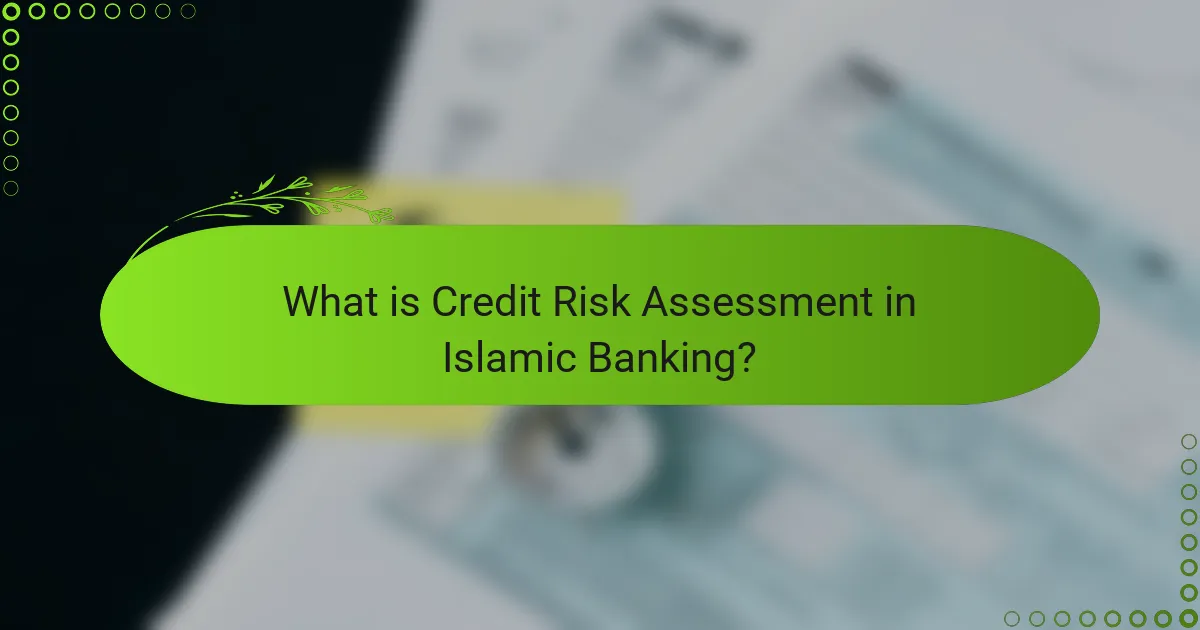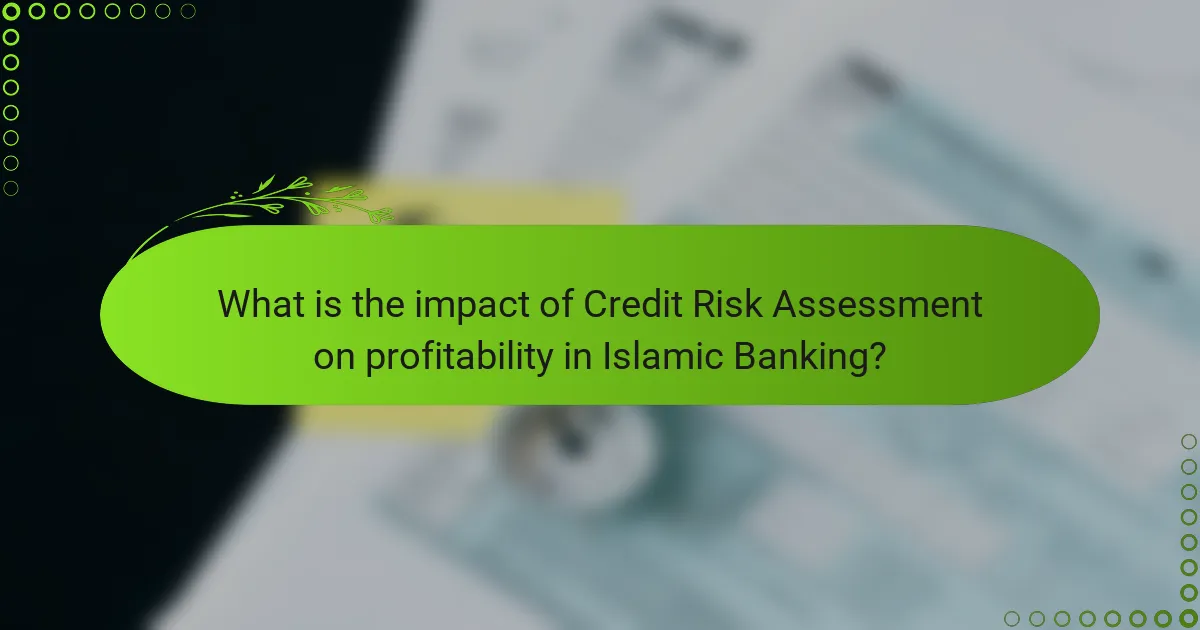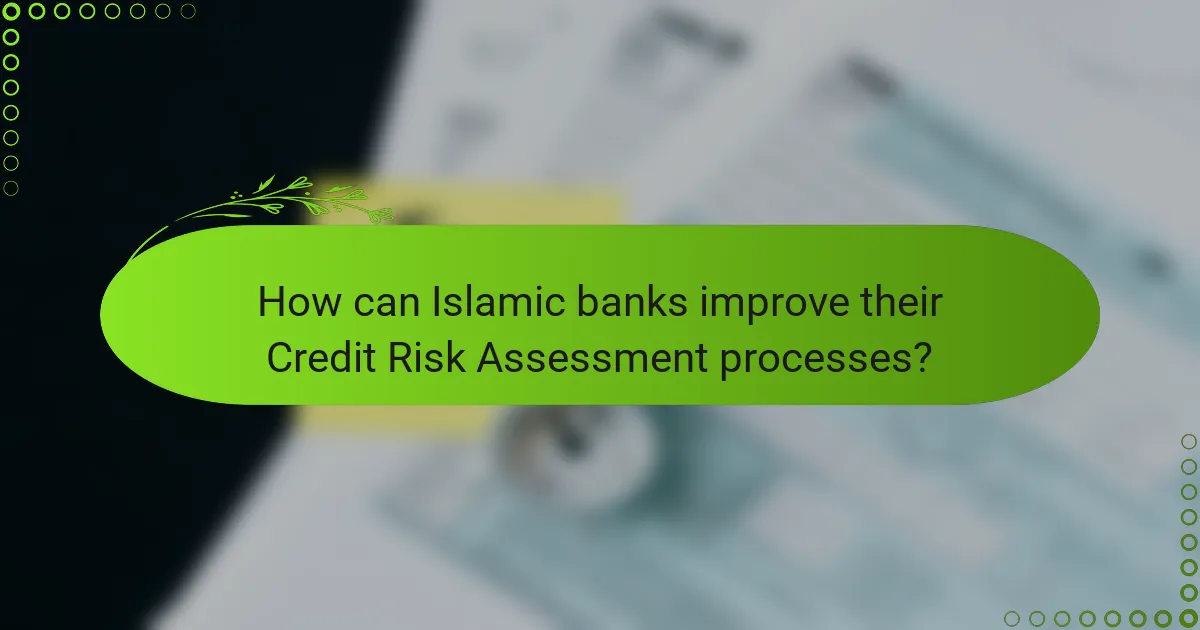
What is Credit Risk Assessment in Islamic Banking?
Credit risk assessment in Islamic banking is the process of evaluating the potential risk of loss due to a borrower’s failure to repay a loan. This assessment is crucial for ensuring compliance with Islamic finance principles, which prohibit interest-based lending. Islamic banks utilize various methods to assess credit risk, including financial analysis, risk grading, and collateral evaluation. These methods help in determining the creditworthiness of borrowers while adhering to Shariah law. The assessment also considers the ethical implications of financing activities, aligning with Islamic values. Effective credit risk assessment can enhance profitability by minimizing defaults and optimizing the allocation of resources.
How does Credit Risk Assessment differ in Islamic Banking compared to conventional banking?
Credit risk assessment in Islamic banking differs significantly from conventional banking due to the prohibition of interest (riba). Islamic banking relies on profit-sharing and risk-sharing principles. This means that credit risk is evaluated based on the viability of the underlying asset or project rather than a borrower’s credit score alone.
In conventional banking, credit assessments focus heavily on the borrower’s financial history and ability to repay loans with interest. Islamic banks, however, assess the ethical implications and compliance with Sharia law alongside financial metrics. The assessment process includes evaluating the business model, market conditions, and potential profitability of the investment.
Furthermore, Islamic banks often require collateral that aligns with Islamic principles, which may not be a requirement in conventional banking. This fundamentally alters the risk profile and management strategies employed by Islamic banks. The approach to credit risk assessment is thus inherently more holistic, integrating both financial and ethical considerations.
What are the fundamental principles of Islamic finance that influence credit risk assessment?
The fundamental principles of Islamic finance that influence credit risk assessment include the prohibition of riba (interest), the emphasis on risk-sharing, and the requirement for ethical investments. Riba prohibits charging interest on loans, which alters the traditional credit risk assessment models. Risk-sharing principles encourage partnerships where both lender and borrower share profits and losses, impacting the evaluation of creditworthiness. Ethical investment requires that financing be directed towards socially responsible projects, influencing the selection of viable credit risks. These principles collectively shape the framework within which credit risk is assessed in Islamic banking, ensuring compliance with Sharia law.
How do Shariah-compliant contracts impact credit risk evaluation?
Shariah-compliant contracts impact credit risk evaluation by introducing unique principles that differ from conventional contracts. These contracts prohibit interest (riba) and emphasize risk-sharing. This alters the risk assessment framework used by financial institutions.
In Shariah-compliant financing, the focus is on asset-backed transactions. This reduces the likelihood of default since the financing is tied to tangible assets. The risk is further mitigated through profit-and-loss sharing arrangements. These arrangements align the interests of the lender and borrower.
Additionally, Shariah compliance requires thorough due diligence. Institutions must assess the ethical and legal compliance of the underlying assets. This can enhance the overall creditworthiness of the transaction.
Studies indicate that Shariah-compliant contracts can lead to lower default rates. Research from the Islamic Financial Services Board supports this, showing that risk-sharing models improve financial stability. Thus, Shariah-compliant contracts significantly influence credit risk evaluation processes.
What are the key methods used in Credit Risk Assessment within Islamic Banking?
Key methods used in credit risk assessment within Islamic banking include qualitative assessment, quantitative analysis, and Shariah compliance evaluation. Qualitative assessment involves evaluating the borrower’s character and management quality. Quantitative analysis focuses on financial metrics such as debt-to-equity ratio and cash flow analysis. Shariah compliance evaluation ensures that the financing adheres to Islamic principles. These methods collectively help in determining the creditworthiness of borrowers in Islamic finance, thereby minimizing risk.
How do qualitative and quantitative methods apply to Islamic credit risk assessment?
Qualitative and quantitative methods are essential in Islamic credit risk assessment. Qualitative methods evaluate subjective factors like management quality and market conditions. They focus on non-numeric data to gauge a borrower’s creditworthiness. Quantitative methods analyze numerical data such as financial ratios and historical performance. They provide measurable insights into a borrower’s ability to repay.
In Islamic finance, qualitative assessments consider Sharia compliance and ethical practices. This ensures that investments align with Islamic principles. Quantitative assessments often utilize metrics like debt-to-equity ratios. These metrics help in understanding financial stability.
Research shows that a combination of both methods leads to a comprehensive risk assessment. For instance, a study by Iqbal and Mirakhor highlights the importance of integrating qualitative insights with quantitative analysis. This integration enhances decision-making in Islamic banking.
What role do stress testing and scenario analysis play in assessing credit risk?
Stress testing and scenario analysis are critical tools in assessing credit risk. They evaluate how financial institutions would perform under adverse conditions. Stress testing simulates extreme economic scenarios to identify vulnerabilities. It helps institutions gauge potential losses and capital adequacy. Scenario analysis examines various hypothetical situations to assess risk exposure. This method allows for a comprehensive understanding of potential credit losses. Both approaches enhance risk management frameworks. They provide insights for strategic decision-making and regulatory compliance. According to the Basel Committee on Banking Supervision, these practices are essential for maintaining financial stability.
What tools are utilized for Credit Risk Assessment in Islamic Banking?
Tools utilized for credit risk assessment in Islamic banking include credit scoring models, risk rating systems, and financial analysis software. Credit scoring models evaluate the creditworthiness of borrowers based on historical data and financial behavior. Risk rating systems categorize borrowers into different risk levels, aiding in decision-making processes. Financial analysis software helps in analyzing financial statements and cash flow projections. These tools ensure compliance with Sharia principles while assessing risk. They also facilitate informed lending decisions, ultimately impacting profitability positively.
Which software and analytical tools are most effective in Islamic banking credit risk assessment?
The most effective software and analytical tools in Islamic banking credit risk assessment include Moody’s Analytics, SAS Risk Management, and FICO. Moody’s Analytics provides comprehensive credit risk solutions tailored for Islamic finance. SAS Risk Management offers advanced analytics for risk assessment and regulatory compliance. FICO delivers predictive analytics to enhance risk decision-making in Islamic banking. These tools utilize data-driven approaches to evaluate creditworthiness while adhering to Shariah principles. They help institutions manage risk effectively and improve profitability. Their effectiveness is supported by case studies demonstrating enhanced risk management practices in Islamic banks.
How do rating agencies contribute to credit risk assessment in Islamic finance?
Rating agencies assess credit risk in Islamic finance by evaluating the compliance of financial products with Sharia principles. They analyze the underlying assets and structures of Islamic financial instruments. This evaluation ensures that investments are ethical and permissible under Islamic law. Rating agencies also provide ratings that reflect the creditworthiness of issuers. These ratings help investors make informed decisions. Furthermore, they enhance transparency in the market. This transparency can lead to increased investor confidence. Ultimately, their contributions support the growth and stability of the Islamic finance sector.

What is the impact of Credit Risk Assessment on profitability in Islamic Banking?
Credit risk assessment significantly impacts profitability in Islamic banking. Effective credit risk assessment helps in identifying and mitigating potential defaults. This process ensures that financial institutions maintain a healthy asset quality. Improved asset quality directly correlates with increased profitability. Research indicates that banks with robust credit risk frameworks report lower non-performing loans. Lower non-performing loans enhance the bank’s overall financial stability. Consequently, this stability fosters higher investor confidence and profitability. Thus, credit risk assessment is crucial for sustainable growth in Islamic banking.
How does effective credit risk assessment enhance profitability in Islamic banks?
Effective credit risk assessment enhances profitability in Islamic banks by minimizing potential losses from defaults. It allows banks to accurately evaluate borrowers’ creditworthiness. This precise evaluation leads to informed lending decisions. Informed decisions reduce the likelihood of non-performing loans. Consequently, lower default rates contribute to higher overall returns. Additionally, effective assessment fosters trust and confidence among stakeholders. This trust can attract more customers and investors. Research indicates that Islamic banks with robust risk assessment frameworks show improved financial performance.
What are the financial metrics used to measure the impact of credit risk assessment on profitability?
The financial metrics used to measure the impact of credit risk assessment on profitability include Return on Assets (ROA), Return on Equity (ROE), and Net Interest Margin (NIM). ROA indicates how effectively a bank uses its assets to generate profit. A higher ROA reflects efficient credit risk management. ROE measures the profitability relative to shareholders’ equity. Effective credit risk assessment can enhance ROE by reducing losses from defaults. NIM assesses the difference between interest income generated and interest paid out. Strong credit risk assessment can lead to improved NIM by minimizing non-performing loans. These metrics provide a clear view of the relationship between credit risk management and overall profitability.
How does credit risk assessment influence the overall risk management strategy in Islamic banks?
Credit risk assessment is crucial in shaping the overall risk management strategy in Islamic banks. It helps identify potential defaults on financing products. By evaluating the creditworthiness of clients, Islamic banks can minimize losses. This process aligns with Shariah principles, ensuring ethical lending practices. Effective credit risk assessment leads to better portfolio management. It allows banks to diversify their investments and reduce concentration risk. Furthermore, accurate assessments enhance regulatory compliance. They ensure that banks maintain adequate capital buffers. Thus, credit risk assessment directly influences the stability and profitability of Islamic banks.
What challenges do Islamic banks face in Credit Risk Assessment?
Islamic banks face several challenges in credit risk assessment. One significant challenge is the lack of standardized risk assessment frameworks. This inconsistency can lead to difficulties in accurately evaluating creditworthiness. Additionally, Islamic banks must comply with Shariah law, which complicates traditional risk assessment models. The absence of historical data on Islamic financing products further hinders effective credit risk evaluation. Furthermore, the reliance on collateral in Islamic finance can create issues in assessing borrower risk. The dynamic nature of economic conditions also impacts the ability to predict defaults accurately. Overall, these challenges can affect the profitability and stability of Islamic banks.
How do regulatory frameworks affect credit risk assessment practices in Islamic banking?
Regulatory frameworks significantly influence credit risk assessment practices in Islamic banking. These frameworks establish guidelines that ensure compliance with Shariah principles. They dictate risk management standards and assessment methodologies. For instance, the Basel III framework impacts capital requirements and liquidity ratios. Islamic banks must adapt their risk assessment to align with these requirements. Furthermore, regulatory bodies often mandate transparency and disclosure, enhancing risk evaluation. This alignment fosters stability and trust in the financial system. Consequently, adherence to regulatory frameworks can improve the overall risk profile of Islamic banks.
What are the common pitfalls in credit risk assessment that can impact profitability?
Common pitfalls in credit risk assessment include inadequate data analysis, over-reliance on credit scores, and lack of qualitative assessments. Inadequate data analysis can lead to misjudgments about a borrower’s creditworthiness. Over-reliance on credit scores may overlook critical factors influencing repayment ability. Lack of qualitative assessments can result in ignoring personal circumstances affecting borrowers. These pitfalls can ultimately lead to poor lending decisions. Poor lending decisions can increase default rates and reduce profitability. Research indicates that effective credit risk assessment is crucial for maintaining financial health. According to a study by the Basel Committee on Banking Supervision, robust risk assessment practices can enhance profitability by minimizing losses.

How can Islamic banks improve their Credit Risk Assessment processes?
Islamic banks can improve their Credit Risk Assessment processes by integrating advanced data analytics. Utilizing big data allows for better risk profiling of potential clients. Enhanced algorithms can assess creditworthiness more accurately. Regularly updating risk assessment models is essential for adapting to market changes. Training personnel on the latest risk assessment tools increases efficiency. Collaboration with fintech firms can provide innovative solutions. Implementing a robust feedback mechanism helps refine risk assessment practices. These strategies lead to more informed lending decisions and reduced default rates.
What best practices should Islamic banks adopt for effective credit risk assessment?
Islamic banks should adopt comprehensive risk assessment frameworks for effective credit risk management. They need to integrate Sharia-compliant principles within their credit evaluation processes. Utilizing robust data analytics can enhance decision-making accuracy. Regularly reviewing borrower creditworthiness is crucial for minimizing potential defaults. Implementing risk mitigation techniques, such as collateral requirements, can safeguard against losses. Training staff on Islamic finance principles ensures adherence to compliance and risk standards. Establishing a risk committee to oversee credit assessments aids in maintaining accountability. These practices align with the unique operational context of Islamic banking and support sustainable profitability.
How can technology enhance the credit risk assessment process in Islamic banking?
Technology can enhance the credit risk assessment process in Islamic banking by improving data analysis and decision-making. Advanced analytics tools can process large datasets quickly. This allows banks to evaluate borrower profiles more accurately. Machine learning algorithms can identify risk patterns that traditional methods might miss. Real-time data integration helps in monitoring financial health continuously. Blockchain technology can enhance transparency in transactions. It ensures compliance with Sharia principles. Digital platforms facilitate better customer engagement and data collection. Overall, technology streamlines the assessment process, leading to more informed lending decisions.
What are the future trends in Credit Risk Assessment for Islamic Banking?
Future trends in credit risk assessment for Islamic banking include enhanced use of artificial intelligence and machine learning. These technologies improve risk modeling and predictive analytics. They allow for more accurate assessments of borrower creditworthiness. Additionally, big data analytics will play a significant role. It enables banks to analyze vast amounts of information for better decision-making.
Regulatory changes are also expected to influence credit risk assessment. Compliance with Shariah law remains a priority. This will drive the development of tailored risk assessment frameworks. Moreover, there is a growing focus on environmental, social, and governance (ESG) factors. These factors are increasingly integrated into credit risk evaluations.
Collaboration with fintech companies is another emerging trend. Such partnerships can enhance the efficiency of credit assessments. Lastly, the adoption of blockchain technology may improve transparency and reduce fraud risks. These trends collectively aim to strengthen the resilience of Islamic banking institutions.
How will emerging technologies shape the future of credit risk assessment in Islamic finance?
Emerging technologies will significantly enhance credit risk assessment in Islamic finance. These technologies include artificial intelligence, blockchain, and big data analytics. AI can analyze large datasets to identify risk patterns more effectively. Blockchain provides transparency and security in transaction records. Big data analytics allows for real-time risk evaluation and personalized financial products.
According to a report by McKinsey & Company, AI can improve risk prediction accuracy by up to 30%. Furthermore, blockchain technology can reduce fraud risk by ensuring data integrity. These advancements lead to more informed decision-making in credit assessments. They also align with Islamic finance principles by promoting ethical lending practices.
Overall, the integration of these technologies will streamline processes and enhance profitability in Islamic banking.
What role will data analytics play in the evolution of credit risk assessment methodologies?
Data analytics will significantly enhance credit risk assessment methodologies. It allows for the analysis of large datasets to identify patterns in borrower behavior. This leads to more accurate risk predictions. Advanced analytics can incorporate non-traditional data sources, improving assessments for underserved populations. Machine learning algorithms can continuously learn and adapt, refining risk models over time. According to a study by McKinsey, organizations that leverage analytics can reduce credit losses by up to 30%. The integration of data analytics in credit risk assessment is essential for improving accuracy and efficiency in decision-making.
What practical tips can Islamic banks implement for better Credit Risk Assessment?
Islamic banks can enhance credit risk assessment by implementing robust due diligence processes. This involves comprehensive evaluation of borrower credentials and financial health. Regular monitoring of borrowers’ financial performance is crucial. Utilizing advanced data analytics can improve risk prediction accuracy. Establishing clear risk rating systems helps in categorizing borrowers effectively. Training staff on Sharia-compliant risk assessment methodologies is essential. Collaboration with credit bureaus can provide additional insights into borrower behavior. Lastly, developing contingency plans for high-risk scenarios ensures preparedness.
Credit risk assessment in Islamic banking is the evaluation of potential losses due to a borrower’s inability to repay loans, adhering to Shariah principles that prohibit interest-based lending. The article covers the differences between Islamic and conventional banking credit assessments, emphasizing the role of ethical considerations and risk-sharing. It discusses key methods and tools used in the assessment process, such as qualitative and quantitative analyses, stress testing, and advanced data analytics. Additionally, the impact of effective credit risk assessment on profitability and the challenges faced by Islamic banks are examined, along with best practices for improving assessment processes and future trends in technology integration.